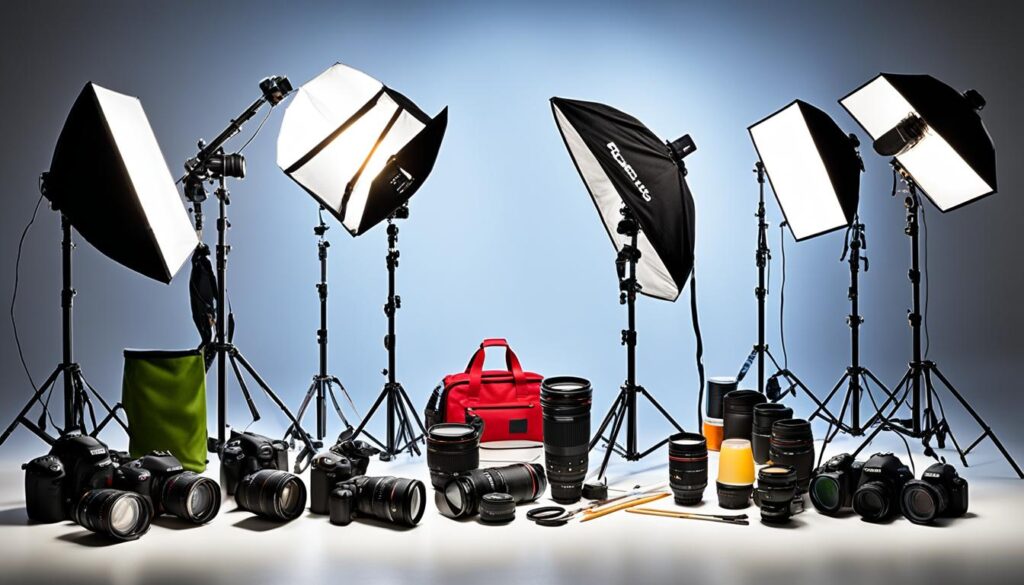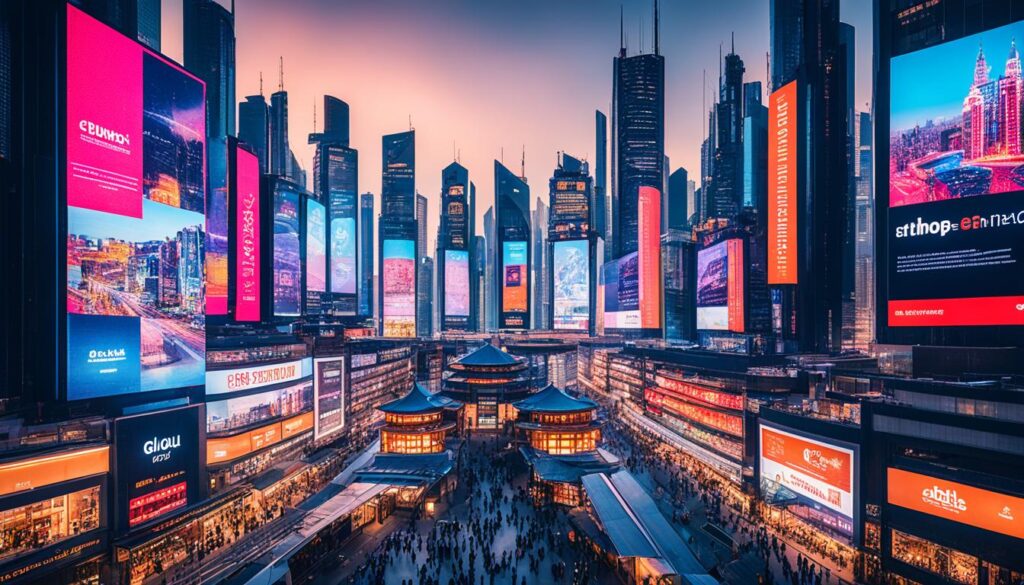Lights, Camera, Commerce: Exploring the World of Commercial Photography
Have you ever held your breath while looking at a fantastic photo? Perhaps it was a colourful picture that seemed to jump out. It might have inspired you, showing you the depth behind an image. This is the magic of commercial photography. It’s an art that does more than take pictures. It communicates, persuades, and makes lifeless objects come to life. You’ll see various styles as you learn about what a commercial photographer does. There’s everything from sleek product shots to vibrant fashion photos. This guide will take you into a world where every photo captures a moment of creativity, precision, and marketing smarts.
Join us as we explore the detailed world of commercial photography. We’ll show you how images move from just an idea to reaching the customer. Whether you’re new and eager to capture the essence of commerce or improving your skills, there’s a space for you. The photography industry keeps growing, offering endless chances for creation and business.
Key Takeaways
- Discover the diverse types of commercial photography and their unique characteristics that captivate and sell.
- Learn how commercial photographers are pivotal in shaping brand image and driving consumer engagement.
- Understand the enduring influence of commercial photography on purchasing decisions in the digital marketplace.
- Glean insights into the essential skills required to succeed as a commercial photographer in a competitive industry.
- Embark on a visual journey with our comprehensive guide to commercial photography, tailoring your perspective to meet commercial aspirations.
The Captivating World of E-commerce and Commercial Photography
Exploring e-commerce, you’ll find that e-commerce photography deeply affects how customers engage. It is vital in the digital marketplace, where the charm of high-quality product images can turn browsers into buyers. In online shopping, every click might lead to a sale, making photography crucial in showing what a product is all about.
Without touching the product, images draw you in and make you want it. Commercial photographers blend skill and art to make products stand out. They aim to stir emotions and highlight the product’s benefits, making it pop off the screen and into the cart.
Imagine a photograph so compelling, it not only shows you the product but convinces you it’s indispensable for your lifestyle. That’s the power of masterful e-commerce photography.
Think about a time you chose between identical products from different sellers. The image’s crispness and story persuade you to click ‘Add to Cart’. Even without touching the product, e-commerce photography builds trust in buyers.
- Detail and texture reveal more than the eye can see.
- Colour and composition that ignite desire.
- A perspective that feels almost real enough to touch.
The digital age makes your product’s first impression crucial. The quality of your images is critical. They should be high-resolution and tell a compelling story. Dive into e-commerce and let commercial photography show the actual value of what you offer.

The world of e-commerce shines through imagery that conveys messages silently. It’s more than just a pretty picture; it’s your brand’s voice. For businesses in online shopping, high-quality product images are a vital investment for success.
In a world where visuals are king, your brand’s story and identity shine through commercial photography. Let’s examine how it becomes vital to brand and e-commerce success. It’s about compellingly painting your brand’s picture for everyone to see.
Defining Commercial Photography in the Digital Age
Photography and filmmaking have grown beyond just art. They are vital for telling stories online. Today, with so many types of photography, each uncovers unique stories. Commercial photography, with the help of tech, highlights your brand. It brings it into the digital world, reaching people everywhere.
Brand Identity and Visual Impact
Brand identity goes beyond words; it’s also about how you look visually. Photographers craft images that reflect what your brand stands for, making your brand strong, recognizable, and unforgettable in people’s minds. It’s about creating a visual connection that lasts.
The Role of Commercial Photography in E-Commerce Success
Great product photos are essential in the busy world of e-commerce. They can make your online shop as good as a real one. These photos show off your products beautifully, helping customers shop with confidence. It’s critical to winning in the online shopping world.
Here’s a look at how commercial photography influences brands online and in stores:
| Aspect | Conventional Retail | E-Commerce |
|---|---|---|
| Customer Interaction | Physical examination of products | Relies on product images for assessment |
| Brand Perception | Reinforced by in-store experience | Defined by consistency in visual content |
| Sales Influence | Dependent on location and footfall | Driven by the allure of high-quality images |
| Global Reach | Limited by geographical boundaries | Expanded through online accessibility |
In conclusion, the balance between images, brand consistency, and consumer behaviour is crucial. In today’s world, stories are told through screens, and sales happen with a click. Commercial photography is more than taking pictures. It’s about creating a visual novel that stands out online, making sure your brand is seen and heard.
Navigating Career Opportunities in Commercial Photography
If you’re eager to start a career in photography, the digital age has brought many career opportunities. You now have many choices, from freelance work to in-house roles. The commercial photography services sector is broad and diverse.
The e-commerce sector is booming, creating more jobs for photographers. There’s a big need for those who can offer full commercial photography services. This includes taking pictures and also editing them to look perfect online.
With your skills and a great portfolio, you can work in many areas, such as:
- E-commerce giants that want to show off their products online.
- Online markets that need good pictures for different sellers.
- Local shops looking to get noticed online with great photos.
- Freelance sites connecting photographers with short or long projects.
- Studios working on ads and commercial shoots.
Being flexible and good at networking is critical to being a freelancer. This way, you can take on various freelance commercial gigs. The photography industry is rich with opportunities.
“Photography is more than capturing moments; it is about weaving a narrative that resonates with the audience and satisfies commercial goals.”
It’s essential to find your particular area and improve your skills. You’ll have the chance to work with famous brands and influence trends, and your unique style could make a significant impact in the commercial world.

| Career Path | Description | Skill Requirements |
|---|---|---|
| Fashion E-commerce Photographer | Capturing clothes for online shops | Knows fashion trends, expert in lighting |
| Product Photographer | Taking pictures of goods for catalogues and websites | Eye for detail, creative setup |
| Food Photography Specialist | Making food look yummy for menus and platforms | Good with colours and textures, styling skills |
| Real Estate and Interiors Photographer | Taking photos of buildings and inside spaces | Can shoot with wide angles, knows HDR photography |
| Creative Director | Heads photo projects for brands and agencies | Leads well, is a good communicator, has a vision |
In a ready market, the choice is yours. Whether you like the structure of corporations or the thrill of freelance work, your talent and drive can lead to exciting photography jobs. These opportunities can fuel your passion and grow your career.
Mastering the Craft: Key Skills for Commercial Photographers
Entering the world of commercial photography means focusing on critical skills. Mastering technical skills and having an artistic touch are vital. They set you apart in this competitive field.
Technical Expertise in Lighting and Composition
Excellent, high-quality photography relies on expert lighting techniques and composition skills. Arranging elements in a photo will tell a story. Lighting equipment helps craft the perfect scene, highlighting your subject’s details.
Creative Post-Processing and Retouching Techniques
Creativity shines in post-processing and retouching. Adobe Photoshop offers tools that turn simple photos into works of art. Patience and a creative hand are essential. They transform basic shots into polished masterpieces.
Brand Consistency and Target Audience Understanding
Being consistent with a brand’s image is crucial. It’s about creating visuals that speak to your target audience. Understanding a brand’s ethos and brand values is essential. Being great at visual storytelling helps a brand tell its story.
Commit to commercial photography and watch your skills blend into visual storytelling. Your technical knowledge, creativity, and strategic insight create engaging visuals.

| Skill Category | Details | Impact on Photography |
|---|---|---|
| Technical Skills | Proficiency in camera functions, understanding of lighting and composition | Enables the creation of technically sound and visually compelling images |
| Lighting Techniques | Use of natural and artificial lighting to enhance mood and detail | Crucial for setting the tone of the photograph and highlighting key aspects |
| Post-Processing and Retouch | Skilful use of Adobe Photoshop for image refinement | Enhances the final presentation, removing imperfections and improving aesthetic appeal |
| Understanding Target Audience | Aligning photography with audience preferences and interests | Ensures the images effectively engage and resonate with viewers |
| Brand Consistency | Maintaining visual cohesiveness across all imagery for a brand | Fosters trust and recognition in the marketplace, supporting brand identity |
These skills and tools prepare you to master commercial photography. Ready to capture attention and embody the stories brands trust you to tell?
The Photographer’s Toolkit: Essential Equipment for Quality Imagery
If you’re entering professional photography, having top-notch gear is key to producing quality images. Some equipment is essential for great work, whether in a studio or on location. Let’s look at what you need in your photography toolkit.

To make your photos stand out, mix technical gear with creative tools. Your primary tool should be a DSLR or mirrorless camera. These, along with diverse lenses, ensure top image quality and flexibility. Also, a strong tripod is crucial for stable shots in different conditions.
| Equipment Type | Purpose | Recommendation |
|---|---|---|
| Camera Body | The foundation of the photography toolkit, capturing the image | DSLR or Mirrorless cameras with full-frame sensors |
| Lenses | Provide perspective and field of view variations for diverse product shots | A range including wide-angle, standard, macro, and telephoto lenses |
| Tripod | Ensures camera stability for sharp, crisp images | Carbon fibre for lightweight durability |
| Lighting Equipment | Controls shadows and highlights, enhancing product details | Diffusers, reflectors, and studio strobes or continuous lights |
| Post-Processing Software | Refines images in editing, from exposure adjustments to retouching | Adobe Photoshop or Lightroom for professional post-processing needs |
| Props and Backdrops | Enhance product appeal and provide context for the imagery | Selection of neutral and themed backdrops, plus a range of stylish props |
Good lighting gear is also key. It helps sculpt your subject with light and shadow, adding depth and highlighting the product’s features. Proper lighting can turn a basic setup into something professional, capturing details.
Remember, in photography, it’s not just the equipment but the skill that matters. Your professional photography will soar with attention to detail and the right tools. You will create sharp, well-lit, and beautifully composed images to impress clients and shoppers. That’s how the right gear can enhance how you present products online.
Insider Views: Industry Experts Share Their Insights
Commercial photography is diverse, with each genre offering unique challenges. Whether you are drawn to high fashion or delicious food photography, success demands a deep understanding of the specific needs of each niche. Industry insiders who have excelled in these areas share their insights on the latest trends and offer advice on building a strong photography portfolio.
From Fashion to Food: Genres of Commercial Photography
Fashion photography tells stories through style and vibrant imagery. It requires teamwork with designers and models to bring creative visions to life. Likewise, food photography uses lighting and angles to make dishes look tempting. To excel in these areas, a photographer must pay attention to detail and appreciate their subjects. This could be the elegance of fashion or the simplicity of homemade bread. Other places, such as portraits, lifestyles, and automobile photography, capture different stories and details.

Impacts of Technology on the Photography Industry
Technology has dramatically changed photography. Adobe software is now essential, offering vast creative and editing possibilities. Drones, VR, and 360-degree cameras introduce new angles and dynamic content. Staying updated with these technologies is crucial for staying competitive. It’s all about using new tools to enhance creativity.
Building a Strong Portfolio: Tips from Pros
A strong portfolio is vital for any commercial photographer. Experts suggest showcasing a variety of styles, from fashion to lifestyle, to demonstrate versatility and skill. A good portfolio also shows you understand clients’ needs and can provide tailored services. It is not just a collection of work but a reflection of your unique style and dedication. Creating a powerful portfolio should be your top goal. It showcases your creativity and expertise.
The Global Marketplace: Commercial Photography Beyond Borders
In the vast world of e-commerce, the limits of commercial photography are fading away. Thanks to the global e-commerce platform, photographers can now show their work to people around the globe. To succeed, they need to understand different cultures and be quick in making content. This makes them stand out in the digital world.
Many think commercial photography is only for big international brands. But it’s crucial for local businesses, too. A single picture can overcome cultural and language barriers. This is key in e-commerce, where how a product looks is everything.

Every photo tells a story for the whole world to see. The market’s diversity demands creativity that understands and celebrates everyone’s unique tastes. Photographers need a wide range of skills. It would be best if you adapted to all clients, from Milan fashion shots to Tokyo tech product photos.
How do you stay relevant and resonant? Keep up with global trends, improve your skills, and work with brands that aim for a worldwide presence.
“The lens of the camera captures what the eye can see, but the heart of a talented photographer reveals a world yet to be explored.”
- Understand cultural diversities and preferences within the global market.
- Refine techniques to produce versatile and adaptable content.
- Partner with entities that value and utilise global outreach.
In the world of e-commerce, the photos you take represent a brand’s message. They connect businesses with customers everywhere. By showing what local and international groups stand for in a good and honest way, you tell stories that touch people all over.
Your camera spotlights local artisans and global luxury brands, bringing them into the worldwide market’s spotlight. So, in skilled hands, commercial photography is a worldwide language. It links products with people and businesses with their future customers.
The Future is Now: Emerging Trends in Commercial Photography
In the world of commercial photography, innovative photography is changing everything. The latest cutting-edge photography technology is transforming how we see visual content. It’s also making online shopping experiences much more exciting.
Interactive 360-degree Imagery and Virtual Try-Ons
At the forefront of innovation is 360-degree product photography. These images let users interact with products like never before. Virtual try-ons allow customers to see products on themselves, helping them feel confident about their online purchases.
This change in e-commerce product photography closes the gap between online and in-store shopping. It makes shopping from anywhere an engaging experience.

Storytelling Through Lifestyle Imagery
Lifestyle photography connects with people on a deep level. Nowadays, customers want stories that feel personal to them. Through storytelling in photography, they can imagine themselves in those stories. This connection is vital in advertising photography.
This style of photography pulls people in by combining creative vision with relatable stories, turning viewers into customers.
Enhancing Mobile E-Commerce Through Visual Content
With more people shopping on mobiles, the focus is on optimizing images for mobile. Creating captivating photography for small screens is challenging. The key is to keep pictures detailed and enticing for people scrolling on their phones.
To master mobile e-commerce photography, photographers aim to create stunning visuals on any device. This approach is setting new standards for the online shopping experience and shows how commercial photography can meet the needs of today’s digital market.
Sharpening Talents: Education and Professional Development
Starting a photography career is exciting. It blends creative skills with technical know-how. A photography degree from a well-known photography institute could be your next big step. These schools do more than teach theory. They provide photography students with practical experience, which helps them perfect their skills. You’ll get to know the latest industry standards by taking photography courses. You’ll also learn to pay close attention to details, which is crucial in a competitive field.
Learning isn’t confined to the classroom. Workshops and webinars are great for professional growth. They let you learn from leading figures in the industry. They’re also great for networking. This means you can meet others and share creative ideas. Keeping up with the latest trends is vital to a thriving career in photography.
- The Institute of Photography’s reputation and accreditation.
- The variety and relevance of photography courses on offer.
- Teaching quality and mentoring opportunities.
- Access to the latest equipment and facilities.
- Chances to gain practical experience.
- Events for networking like workshops and exhibitions.
It’s good to think about how well the education fits with the industry:
| Education Component | Industry Relevance |
|---|---|
| Theoretical Understanding | Essential knowledge for practical skills |
| Technical Training | Preparation for actual shoots |
| Artistic Development | Standing out creatively in the market |
| Business Acumen | Managing oneself and being entrepreneurial |
| Networking Opportunities | Creating professional connections for the future |
A well-respected photography degree and active professional development can set you up for success. It mixes academic work and practical application, preparing you for today’s jobs and tomorrow’s photographic advances. Remember, the best investment is in your skills. The outcomes will be rewarding.
Picture-Perfect Business: A Guide to Developing a Photography Strategy
Visuals lead today’s market. Converting brand marketing with photos requires a strong plan. It’s vital to tell visual stories that connect, enhancing how you stand out online.
Integrating Photography into Marketing Strategies
Adding photos to your marketing gives your brand a feeling. Photos show what your company stands for at a glance. They’re like meeting your customers for the first time, but visually.
Choosing the right photos is critical. They should fit your brand’s story. This helps your brand’s position grow stronger with every photo you share.
Choosing the Right Photography Services for Your Brand
Choosing an exemplary photo service is critical. It would be best to have experts who get e-commerce and product shots. Your choice should match your brand’s vibe, whether it’s a known studio or a new advisor.
A photo consultant sharpens your story. The exemplary service will show your brand’s message and attract your audience.
The Interplay Between Photography and Filmmaking in Advertising
Photos and films together make ads powerful. They turn campaigns into engaging stories. While photos grab attention, films unfold the story, offering an in-depth experience.
Compelling visuals are not just about one good image. They’re about telling a story through pictures. A strategic photography approach boosts visibility, engagement, and growth. Remember this as you build your visual strategy.
Conclusion
The world of commercial photography is an ever-evolving journey. It combines art, modern technology, and business. High-quality images are essential for any brand wanting to stand out visually. They help connect with audiences in a meaningful way. Every picture crafted aims to tell a whole story, not just capture a moment.
Success in commercial photography is within reach for those who put in the effort. This can be through a photography course, self-teaching, and networking. Our discussion shows the importance of skill and understanding visual storytelling. Commercial photographers play a crucial role. They are the silent architects of brands’ visual language to share their stories.
Opportunities are everywhere in the vibrant world of commercial photography. You are becoming successful means blending learning with doing, being creative, and being aware of the business side. As we end our journey, remember that your path in photography is about creating visions that turn the ordinary into the extraordinary. Every image you take should help build your successful career.
FAQ’s
Q: What are the different types of commercial photography?
A: Commercial photography includes e-commerce photography, advertising photography, product photography, and more.
Q: How important is high-quality photography for e-commerce websites?
A: High-quality product images on e-commerce websites can drive sales and attract potential customers.
Q: Do I need a photography degree to become a successful commercial photographer?
A: While a photography degree can be beneficial, many successful commercial photographers are self-taught professionals.
Q: What role does Adobe Photoshop play in commercial photography?
A: Adobe Photoshop is a widely used tool for editing and enhancing commercial images to create high-quality results.
Q: Why is photography crucial for advertising products or services?
A: Photography is crucial in advertising as high-quality images can effectively showcase products, attract customers, and drive sales.
Q: How does collaboration play a role in commercial photography?
A: Commercial photographers often collaborate with clients, art directors, and stylists to create successful commercial images for various needs.
Q: What makes a photographer successful in the commercial photography industry?
A: A successful commercial photographer understands the commercial use of photography, delivers high-quality images, and meets clients’ needs to sell products effectively.








